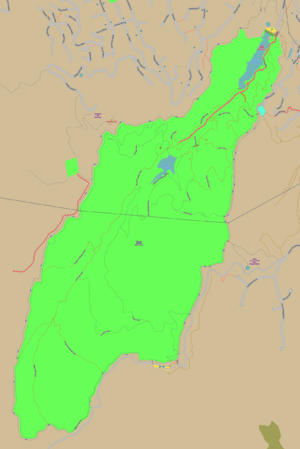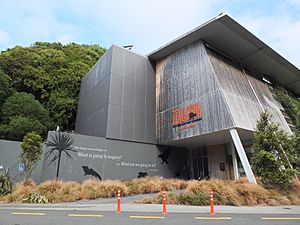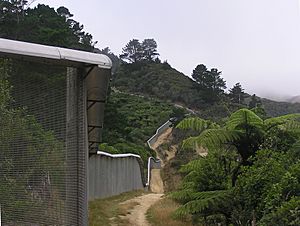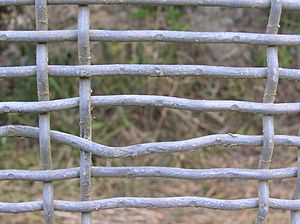Zealandia (wildlife sanctuary) facts for kids
Quick facts for kids Zealandia |
|
|---|---|
| Karori Wildlife Sanctuary | |
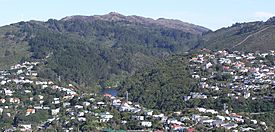
Zealandia on the edge of suburban Wellington
|
|
| Type | Wildlife sanctuary |
| Location | Wellington, New Zealand |
| Area | 225 hectares (560 acres) |
| Created | 1999 |
| Operated by | Karori Sanctuary Trust |
| Open | All year around except 25 December |
| Website | https://www.visitzealandia.com/ |
Zealandia, also known as the Karori Wildlife Sanctuary, is a special nature area in Wellington, New Zealand. It's the world's first completely fenced "eco-sanctuary" in a city! Here, people are working to bring back the amazing variety of plants and animals (biodiversity) in 225 hectares (that's about 556 acres) of forest. This area used to be where Wellington got its water.
For a long time, many of New Zealand's natural places were harmed by animals that weren't originally from there, like stoats, rats, and possums. These animals caused big problems for native plants and animals. Zealandia is surrounded by a special fence that keeps these harmful animals out. This makes it like an "ecological island" where the original plants and animals can grow and thrive again.
Zealandia has become a very popular place to visit in Wellington. Because of the sanctuary, you can now see more native birds like tui and kākā flying around in the city's suburbs!
Zealandia has inspired many other similar projects across New Zealand. Predator-proof fences now protect nature in other forests too. Some examples are Riccarton Bush, Bushy Park, and the huge Maungatautari Restoration Project, which protects an entire mountain!
Contents
History of Zealandia
A long time ago, about 60% of the Wellington area was covered in thick forest. Trees like karaka, kohekohe, ngaio, and nikau were common. There were also rata, rewarewa, and tawa trees, plus large podocarps like kahikatea and rimu. The whole valley where Zealandia is now was covered in this forest.
But then, European settlers arrived, and big fires in 1850 and 1860 cleared the land for farming. The lower reservoir, which held water, was finished in 1878. Parts of the area were farmed until 1906, when the rest of the land was bought for the city's water supply. The upper reservoir was finished in 1908.
From then on, because the valley was a protected area for Wellington's water, new trees were planted, and the native forest started to grow back. The upper dam stopped being used for water around 1991, and the lower one in 1997.
A conservationist named Jim Lynch had the idea for a wildlife sanctuary here. In 1993, a study showed that this valley was perfect for a sanctuary because it was a large, self-contained home for many native plants and animals. After talking to the public in 1994, the idea for the sanctuary was approved. The Karori Wildlife Sanctuary Trust was created in 1995 to build this "mainland island" sanctuary.
The Special Fence
The most important part of Zealandia is its special fence. This "pest-exclusion fence" is designed to keep out 14 types of non-native animals, from deer to mice. The fence goes all the way around the sanctuary, covering 8.6 kilometers (about 5.3 miles). The fence was finished in late 1999. After that, all the harmful animals inside the fence were removed over nine months. This predator-proof fence was the first of its kind in the world, making it very important for conservation.
Animals Kept Out by the Fence
The fence is designed to stop these animals from getting into the sanctuary:
The fence was designed after testing how different animals tried to get past it. It has a very small mesh (holes) to stop even tiny mice. It also has a curved top to stop animals from climbing over, and a part that goes underground to stop them from digging under.
The fence has been very successful in helping Zealandia meet its goals. It has kept almost all harmful animals out. Only tiny mice have managed to get back in, possibly through small damaged spots in the fence. The sanctuary is looking at ways to keep mice out permanently. Sometimes, weasels and rats also get in, for example, if a storm damages the fence. But the sanctuary staff constantly check for these animals and remove them.
Restoring the Forest
The plants and animals in Zealandia are recovering well from when the area was damaged. Even though the forest started growing back in 1906, it's still in the early stages. Small, tough trees like mahoe are common. But some of the original large trees, like rimu, matai, miro, kahikatea, and totara, are missing or rare. These are being replanted. Northern rātā trees had almost disappeared from the valley, and many seedlings have been planted. Many different native trees that help native animals are already growing, including a group of mature New Zealand tree fuchsia trees.
Amazing Species at Zealandia
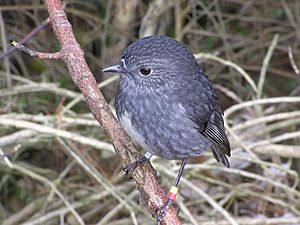
Zealandia is home to many incredible native animals. Since 2000, many native birds and other animals have been released into the sanctuary.
- Native Birds that have been released:
- Bellbird (korimako)
- Brown teal (pāteke)
- Kākā, North Island
- Kākāriki, red-fronted parakeet
- Little spotted kiwi (kiwi pukupuku)
- Pigeon, New Zealand (kererū)
- Robin, North Island (toutouwai)
- Saddleback, North Island (tīeke)
- Scaup, New Zealand (papango)
- Stitchbird (hihi)
- Takahē, South Island
- Tomtit, North Island (miromiro)
- Weka, North Island
- Whitehead (pōpokatea)
- Rifleman (tītipounamu)
- Other Native Animals that have been released:
- 70 tuatara from Stephens Island
- 100 giant weta (a large insect)
- 21 Maud Island frogs
- Spotted skink
- 200 New Zealand freshwater mussel (kākahi)
- Other Native Species that live naturally in the area without needing to be moved there:
- Birds
- Black shag (kawau pū)
- Fantail, North Island (piwakawaka)
- Falcon, New Zealand (kārearea)
- Grey warbler, New Zealand (riroriro)
- Little black shag (kawau tūī)
- Little shag (kawau paka)
- Pied shag, New Zealand (kāruhiruhi)
- Morepork (ruru)
- Silvereye (tauhou)
- Shining cuckoo (pipiwharauroa)
- Tui
- Birds
-
- Reptiles
- Common gecko
- Forest gecko
- Brown skink
- Common skink
- Copper skink
- Ornate skink
- Reptiles


